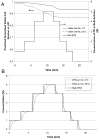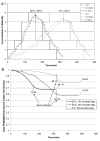Mathematical modeling of cryoprotectant addition and removal for the cryopreservation of engineered or natural tissues
- PMID: 22142903
- PMCID: PMC3246576
- DOI: 10.1016/j.cryobiol.2011.11.006
Mathematical modeling of cryoprotectant addition and removal for the cryopreservation of engineered or natural tissues
Abstract
Long-term storage of natural tissues or tissue-engineered constructs is critical to allow off-the-shelf availability. Vitrification is a method of cryopreservation that eliminates ice formation, as ice may be detrimental to the function of natural or bioartificial tissues. In order to achieve the vitreous state, high concentrations of CPAs must be added and later removed. The high concentrations may be deleterious to cells as the CPAs are cytotoxic and single-step addition or removal will result in excessive osmotic excursions and cell death. A previously described mathematical model accounting for the mass transfer of CPAs through the sample matrix and cell membrane was expanded to incorporate heat transfer and CPA cytotoxicity. Simulations were performed for two systems, an encapsulated system of insulin-secreting cells and articular cartilage, each with different transport properties, geometry and size. Cytotoxicity and mass transfer are dependent on temperature, with a higher temperature allowing more rapid mass transfer but also causing increased cytotoxicity. The effects of temperature are exacerbated for articular cartilage, which has larger dimensions and slower mass transport through the matrix. Simulations indicate that addition and removal at 4°C is preferable to 25°C, as cell death is higher at 25°C due to increased cytotoxicity in spite of the faster mass transport. Additionally, the model indicates that less cytotoxic CPAs, especially at high temperature, would significantly improve the cryopreservation outcome. Overall, the mathematical model allows the design of addition and removal protocols that insure CPA equilibration throughout the sample while still minimizing CPA exposure and maximizing cell survival.
Copyright © 2011 Elsevier Inc. All rights reserved.
Figures








Similar articles
-
Cryoprotectant delivery and removal from murine insulinomas at vitrification-relevant concentrations.Cryobiology. 2007 Aug;55(1):10-8. doi: 10.1016/j.cryobiol.2007.04.002. Epub 2007 Apr 10. Cryobiology. 2007. PMID: 17533114 Free PMC article.
-
Cytotoxicity effects of cryoprotectants as single-component and cocktail vitrification solutions.Cryobiology. 2011 Apr;62(2):115-22. doi: 10.1016/j.cryobiol.2011.01.012. Epub 2011 Jan 22. Cryobiology. 2011. PMID: 21262212 Free PMC article.
-
Cryoprotectant transport through articular cartilage for long-term storage: experimental and modeling studies.Osteoarthritis Cartilage. 2008 Nov;16(11):1379-86. doi: 10.1016/j.joca.2008.03.027. Epub 2008 Jun 9. Osteoarthritis Cartilage. 2008. PMID: 18539055 Free PMC article.
-
Cryoprotectants: A review of the actions and applications of cryoprotective solutes that modulate cell recovery from ultra-low temperatures.Cryobiology. 2017 Jun;76:74-91. doi: 10.1016/j.cryobiol.2017.04.004. Epub 2017 Apr 18. Cryobiology. 2017. PMID: 28428046 Review.
-
The need for novel cryoprotectants and cryopreservation protocols: Insights into the importance of biophysical investigation and cell permeability.Biochim Biophys Acta Gen Subj. 2021 Jan;1865(1):129749. doi: 10.1016/j.bbagen.2020.129749. Epub 2020 Sep 25. Biochim Biophys Acta Gen Subj. 2021. PMID: 32980500 Review.
Cited by
-
Cryopreservation of NK and T Cells Without DMSO for Adoptive Cell-Based Immunotherapy.BioDrugs. 2021 Sep;35(5):529-545. doi: 10.1007/s40259-021-00494-7. Epub 2021 Aug 24. BioDrugs. 2021. PMID: 34427899 Free PMC article. Review.
-
Vitrification of particulated articular cartilage via calculated protocols.NPJ Regen Med. 2021 Mar 19;6(1):15. doi: 10.1038/s41536-021-00123-5. NPJ Regen Med. 2021. PMID: 33741977 Free PMC article.
-
Rapid quantification of multi-cryoprotectant toxicity using an automated liquid handling method.Cryobiology. 2021 Feb;98:219-232. doi: 10.1016/j.cryobiol.2020.10.017. Epub 2020 Nov 4. Cryobiology. 2021. PMID: 33157080 Free PMC article.
-
Toxicity Minimized Cryoprotectant Addition and Removal Procedures for Adherent Endothelial Cells.PLoS One. 2015 Nov 25;10(11):e0142828. doi: 10.1371/journal.pone.0142828. eCollection 2015. PLoS One. 2015. PMID: 26605546 Free PMC article.
-
Rational synthesis of total damage during cryoprotectant equilibration: modelling and experimental validation of osmomechanical, temperature, and cytotoxic damage in sea urchin (Paracentrotus lividus) oocytes.PeerJ. 2023 Sep 1;11:e15539. doi: 10.7717/peerj.15539. eCollection 2023. PeerJ. 2023. PMID: 37671360 Free PMC article.
References
-
- Arav A, Natan Y. Directional Freezing: A Solution to the Methodological Challenges to Preserve Large Organs. Seminars in Reproductive Medicine. 2009;27:438–442. - PubMed
-
- Balasubramanian SK, Coger RN. Heat and mass transfer during the cryopreservation of a bioartificial liver device: A computational model. Asaio Journal. 2005;51:184–193. - PubMed
-
- Bird RB, Stewart WE, Lightfoot EN. Transport Phenomena. John Wiley & Sons, Inc; New York, NY: 2002.
MeSH terms
Substances
Grants and funding
LinkOut - more resources
Full Text Sources

